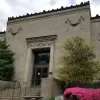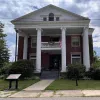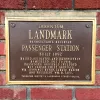Jonas J. Pierce House is a large, stylish Second Empire residence that is a full-blown and early example of the architectural style. This house retains most of its original interior and exterior architectural detail.
Historic Houses
The Kane Depot was built in 1873. An extension was made to the original building in 1890. The first railroad to operate through the depot was the Philadelphia/Erie Railroad.
The early nineteenth century was a time of settlement and commercial development in Western Pennsylvania. Kingston House played a significant role in that activity. Built along a heavily traveled east-west highway, the house served as a stop for numerous settlers, traders, and travelers.
Anoatok was built in 1896-97 for Dr. Elizabeth Dennistoun Wood Kane as a residence for her and her two sons, Dr. Evan O'Neill Kane and Dr. Thomas L. Kane, and their families. In terms of its architectural style, history, and physical location, it is the most prominent residence in Kane.
Mount St. Peter Roman Catholic Church is rectangular in shape and is constructed of concrete block faced with red Michigan sandstone. The narthex is a series of small blocks, increasingly larger in size as one enters into the nave. The Mount St.
The New Thomson House, situated at the intersection of the two principal thoroughfares in Kane and directly opposite the Pennsylvania Railroad Station, is the most prominent building in the community.
The Anthony Wayne Cook Mansion is set in a large landscaped yard approached by three stone gates. Anthony Wayne Cook's heirs are restoring the Queen Anne-style, hipped-roof, frame Mansion.
The B.F. Jones Memorial Library is a restrained Italian Renaissance-style limestone structure built in 1928.
The Sutton-Ditz House was erected in 1850 by Thomas Sutton, a young attorney who settled in Clarion County when it was established on 11 March 1839. He was accepted into the Bar Association in 1841 and quickly became a respected and admired attorney in the Clarion area.
Originally called the Woodlawn Station, this building was constructed in 1910, making it one of the P. & L.E. Railroad Company's later passenger stations.
Constructed in 1826 for an extended family of entrepreneurs, the Waugh House is Greenville, Pennsylvania's earliest documented standing residence. Its exterior appearance and original plan remain in a perfect state of integrity.
The Cashier's House was designed and built in 1837-1839 by Philadelphia architect William Kelly. It was built as the home for the chief executive officer of the Bank of the United States, Erie Branch, which was located directly beside the house.
Bonifels is a large, two-and-a-half-story stone mansion located on a hilltop overlooking the town of Ridgway. The house is T-shaped in plan, with small, one-story wings at the inner corners of the T. It has hipped roofs with hipped roof dormers, a conical tower, and a crenelated square tower.
Built about 1855, the Gibson House was the home of Dr. William Gibson and his wife, Susan. Dr. Gibson settled in Jamestown in 1836 and established a flourishing medical practice. Besides serving as the town's physician, Dr.
The St. Gertrude Church was built in 1911 by the Dusquesne Construction Company on land purchased by the Arch Abbott Boniface Wimmer, the founder of St. Vincent's College and Seminary. The church is a basilica plan with a central pavilion that slightly projects from twin campaniles.
The Karolcik Building was built and managed by Michael (Mike) Karolcik (1890-1978), whose parents came from Slovakia; his father settled in the Frick Company coal town of Leisenring, Fayette County, where he worked as a miner. Mike Karolcik worked at the Krell Store in nearby Whitsett as a boy.
The Youghiogheny (or Youghogeni) Bank of Pennsylvania (also known as Old State Bank) was built circa 1817 as one of the first formally organized banks in the western part of the state. The opening of this bank reflects the optimism of this fledgling community.
Searight's Fulling Mill is an early fulling mill of Western Pennsylvania. It was built around 1810 and measures approximately 20 feet by 30 feet. It is a 2½ story, gable-roof structure constructed of sandstone.
George Washington’s Gristmill Park includes the following:George Washington’s 1776 GristmillThe original foundation was restored in 1992; the 3-story framework was rebuilt in 1999.
In 1754, Jonathan Hill lived in the Fayette County area and was one of its earliest settlers. He first owned property in what is now known as Smock in 1785. He owned 105 acres, two horses, and one cow. He also owned one of the first grist mills in 1790, with his location on Redstone Creek.
Kane Armory was built in 1922 for the 112th Infantry of the Pennsylvania National Guard, with a front administrative section added later, in 1929. It is one of at least thirty-seven armories in Pennsylvania laid out on a T plan. The armory was designed by W. G. Wilkins Company and Joseph F.
The Tarentum Station was built in 1892 and moved to its present location in 1913. It has welcomed many important visitors, including Kit Carson, William Jennings Brian, Carrie A. Nation, and President Willaim Howard Taft.
The original residential portion of the Club was built for Warren businessman Myron Waters (1817- 1901), who was said to have been the third wealthiest man in Warren when he built his new mansion on Market Street in 1872. Waters had come to Warren ca.






















